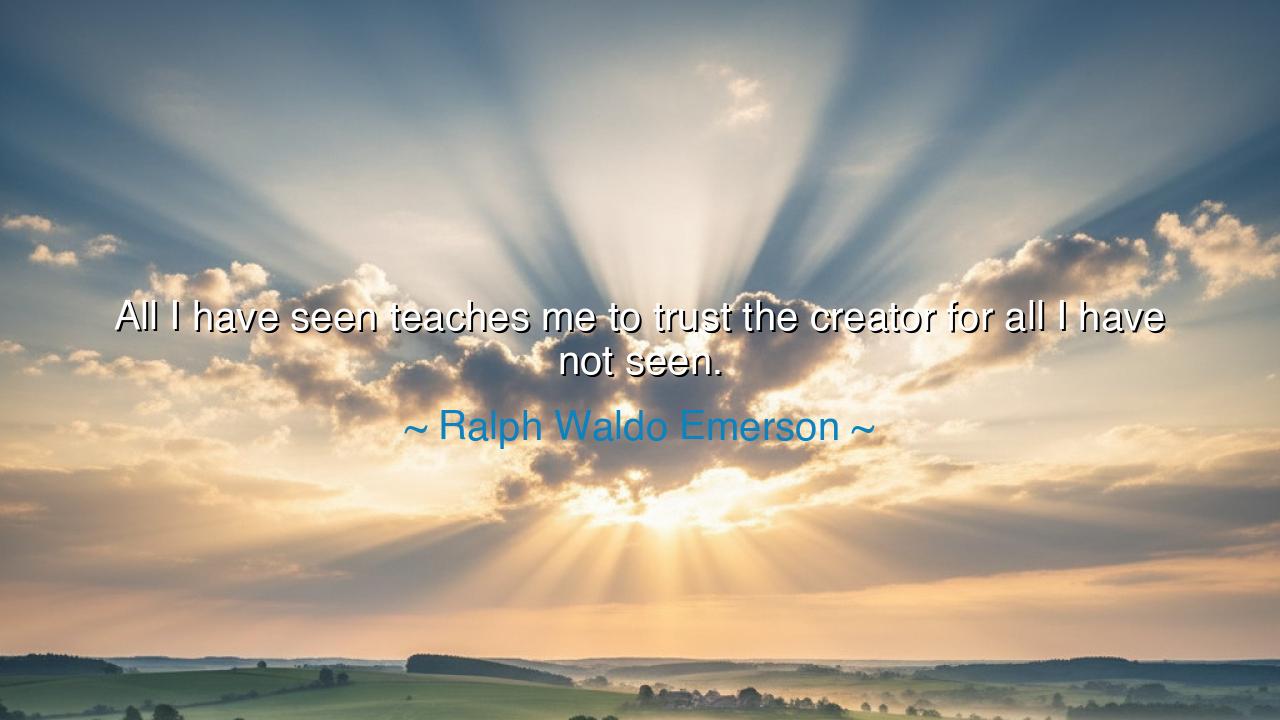
All I have seen teaches me to trust the creator for all I have






Hear the voice of Ralph Waldo Emerson, sage of Concord and prophet of transcendence, who declared: “All I have seen teaches me to trust the Creator for all I have not seen.” These words rise from the heart of one who looked upon nature, upon humanity, upon the vastness of existence, and found in them not despair but faith. Emerson teaches us that the world itself is scripture, that every sunrise, every seed, every star proclaims the wisdom of a Creator who governs what is hidden just as surely as what is revealed.
To say that “all I have seen” instructs him is to recognize that the visible world is a teacher. The changing of seasons, the persistence of life, the grandeur of mountains, and the tender cry of a child—all these are testimonies to order, beauty, and meaning. And if the Creator has so arranged what we behold with such harmony, then surely He can be trusted with that which lies beyond our sight: the unknown future, the mystery of suffering, the destiny of the soul. Thus Emerson’s faith is not blind—it is sight transfigured into trust.
The origin of these words flows from Emerson’s philosophy of Transcendentalism, which held that the divine is present in all things, and that nature itself is a doorway to eternal truths. He believed that by contemplating the visible world, man could touch the invisible. For him, the forest was a cathedral, the stars a scripture, and the human spirit a reflection of the divine. His quote is not a dogma but an invitation: look around you, and let the majesty of creation teach you faith for what is unseen.
History offers a mirror of this wisdom. Consider Isaac Newton, who studied the heavens not to doubt but to deepen his reverence. By observing the movements of planets, he discerned laws of gravity and motion, but he did not see them as diminishing God. Rather, all he had seen in the cosmos taught him to trust the Creator who set the stars in their courses. The visible became a bridge to the invisible; the discovered revealed the faithfulness of the undiscovered. Emerson’s words find harmony in Newton’s life: knowledge need not destroy faith, but can strengthen it.
The emotional power of Emerson’s saying lies in its reassurance against fear. We tremble at the unknown—the future, the afterlife, the mysteries of suffering and death. But Emerson counsels us: look to what you have already seen. Life has been sustained, beauty has been revealed, and meaning has been glimpsed. If the Creator has not failed in what is visible, why should He fail in what is hidden? Thus the heart can rest, not in ignorance, but in confidence born of experience.
The lesson is both noble and practical: nurture faith through observation. When doubt rises, walk among the trees, gaze at the night sky, hold the hand of one you love, remember the strength that carried you through past trials. Let what you have seen teach you trust for what you have not yet faced. The Creator is consistent, and His patterns in nature reflect His reliability in mystery.
Practical actions follow: cultivate stillness in nature, reflect on past providence, record moments of beauty and resilience that you have witnessed. When fear of the future overwhelms you, return to these testimonies as Emerson did. Say to yourself: “I have seen life rise again after winter, I have seen light after darkness, I have seen hope born after despair. Therefore I will trust.” In this way, faith is not mere belief but a discipline of remembrance.
So let Emerson’s words be carved into the soul: “All I have seen teaches me to trust the Creator for all I have not seen.” Let the world itself be your teacher, every leaf a lesson, every dawn a promise. Then the unknown will no longer be a terror but a mystery embraced with courage. For he who trusts in what is unseen has already learned from what is seen that the Creator is faithful. And such faith will carry the soul through darkness into light, through doubt into peace, through death into eternity.






AAdministratorAdministrator
Welcome, honored guests. Please leave a comment, we will respond soon